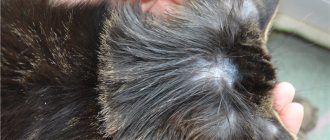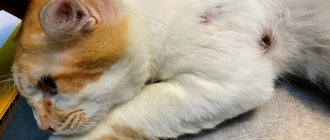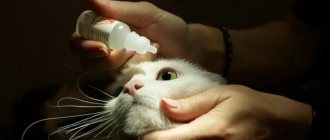Welcome, dear readers, to the cat care blog!
Information on how to cure a particular disease is a purely medical thing, but in what cases to seek help from doctors is useful for us to know!
And although today the reason for communication is very serious, as you will see for yourself, in the end everything will be fine, believe me, if the matter is not taken too far!
So what should you do if your cat has yellow discharge? But they are not only yellow!
Let's take a look at all the reasons for such phenomena, shall we? Caring and attentive owners need to be aware of what is happening in the animal’s body. Do you agree?
"What's happening?!"
A reasonable question if you suddenly notice something wrong under the tail of your always (and everywhere!) neat and tidy little cat!
And the reasons for the discharge, depending on its color, can be natural (due to physiological processes) and pathological:
- Transparent, homogeneous, odorless - the norm during the period of estrus, but if they last longer than three days, an odor appears, they become cloudy and yellow - immediately consult a veterinarian.
- White; sometimes yellowish; bloody - shortly before birth;
- Transparent; fawn or greenish - after the start of contractions, amniotic fluid flows out;
- From yellow or dark green to brown - after birth from several days to 3 weeks.
- If long before birth, they are gray, smell unpleasant, and appear in the form of pus - medical attention is required! This is also dangerous for kittens.
- Constant and watery, and sometimes with blood, is not the norm; this happens when the placenta does not leave after childbirth.
- Bloody, but behavior as in estrus (and there should be no blood normally) - these are symptoms of pyometra in an open form (purulent inflammation of the uterus); There are also other types of discharge: creamy; brown; yellow; green; pus mixed with blood. Without treatment - a fatal and painful outcome within a period of 2 days to 1-5 weeks from the onset of visible symptoms. But the closed form of pyometra... there are no visible symptoms - this is its danger! - after all, they notice it when it may already be too late.
- Pink or opaque (purulent) - urinary tract or uterine infections;
- Cloudy, yellowish, bloody, with an unpleasant odor - endometritis; sometimes it begins 2-3 days (!) after birth; “insidiousness” of endometritis: outwardly you feel good, estrus occurs, but pregnancy does not occur; if left untreated, the situation will worsen greatly;
- Drops or clots of blood - hematometer;
- Smearing or in the form of meager drops - hydrometer (the last two ailments are a threat to life).
- Bloody or purulent - the likelihood of cancer of the urogenital tract.
- Watery or mucous - inflammation of the vagina.
- Abnormal bleeding is a symptom of a bleeding disorder (it is difficult to distinguish from blood in the urine).
- Bloody, watery or purulent - injury or the presence of a foreign body in the vagina.
- Watery... feces - this happens in case of defects or fistulas between the rectum and vagina.
- Persistent - with a problem with the sphincter of the bladder or with an abnormal position of the ureter, then urine enters the vagina and irritates it, hence the constant discharge from it.
Normal discharge in a cat before giving birth
A few days before the onset of contractions (usually from 63 to 65 days of pregnancy), the body begins to prepare for childbirth. Normally, the mucus plug comes off about a day before the onset of contractions. However, as the experience of owners shows, the mucous plug can come off several weeks before birth.
Note! The mucus plug may be streaked with blood as the blood supply allows it to renew and enlarge as the kittens grow.
In any case, if you notice that there is pink discharge left on your cat’s fur, most likely these are traces of a mucus plug. The pigmentation of the mucus plug can vary from clear to creamy to greenish in color. The volume of mucus released is an individual indicator. Most owners do not monitor the process of the mucus plug coming out, since it is very small and remains in the litter tray after urination.
Additional symptoms
For different diseases, the following are possible:
- increased and/or difficulty urinating, which is painful and can therefore cause anxiety and even aggression;
- it’s hard for the poor thing to go “big”;
- for a long time the cat rubs its butt on the floor (or rolls on the floor);
- licks himself from behind too often, because the discharge irritates the skin;
- complete apathy; drowsiness; vomit; fever; increased thirst; poor appetite; abdominal enlargement.
How to help your pet
Loving owners always strive to help their pet. Whatever the methods, they must first of all be safe. If a cat is in heat, you need to encourage her natural urges and find a cat to breed. If you really don’t want your pet to have offspring, then you can “bring her back to her senses” with the help of special medications. For example, a special ointment that is applied to the nose every day. The animal will quickly return to its usual behavior and stop meowing loudly and chasing its owners.
Reference! If the discharge is not associated with estrus, then the best thing the owner can do is take the cat to the veterinarian, or call him at home (but if the disease is serious, then transportation to the clinic will be required).
The above diseases, after reading, should lead to the conclusion that the discharge indicates serious and dangerous diseases. Therefore, it is almost impossible to help your pet at home. Loss of appetite, baldness, deterioration in general condition and other dangerous symptoms cannot be “removed” on your own.
A reason to consult a specialist!
In all of the above dangerous (!) situations, you should not risk the health of your tailed pet and “make a diagnosis” on Internet forums - “guess the tea leaves”, but it is better to consult with a veterinarian by toll-free phone, then make a house call or make an appointment , if required.
Then timely treatment will return the mustachioed and striped beauty to excellent health, and you will be in a good mood! And may it “never leave you again!”
Physiological reasons
Physiological are considered reasons that cause discharge due to the characteristics of the body. Before giving birth, the female will have a plug, which is also a hard clot of mucus that comes out before giving birth. It does not bode well: it is necessary to “remove” everything unnecessary from the surface of the labia and prevent the occurrence of infections as a result of the introduction of harmful bacteria during childbirth.
Discharge from a pregnant cat: bloody, yellow
After your cat gives birth, she may continue to have mucus coming from her vaginal opening and anus for some time. Color – reddish or dark brown interspersed with greenish color. The norm is 3 weeks after birth. Due to the fact that during childbirth the discharge is red (the cat has bloody discharge), after the birth of the kittens the mucus will also have a reddish tint, which will gradually turn into a brown tint and disappear.
Reference! True, during pregnancy, yellow mucus sometimes comes out - amniotic fluid.
But not everything is as simple as it seems. There are much more dangerous secretions that indicate the presence of health problems. If they are not related to pregnancy, then they are not difficult to recognize. The next step is to determine the type, cause and prescribe the correct treatment.
Dangerous diseases arise as a result of infections that enter the body through the external environment, contact with other animals and sexual intercourse.
2. Reasons
The least dangerous cause can be considered abnormally liquid sulfur, as the secretion of the ceruminous glands of the external auditory canal is colloquially called. Due to individual characteristics and/or under the influence of certain irritating factors, the sulfur glands can produce protective “lubricant” in excess quantities and with atypical rheological properties. This situation, however, also requires mandatory consultation with an otolaryngologist.
Relatively rare is cholesteatoma, a complex encapsulated formation of dead cells, connective tissue and cholesterol; this is a pseudotumor, which, in the case of an associated infection, can lead to otorrhea (discharge from cholesteatoma, as a rule, has a specific putrefactive odor).
However, in the vast majority of cases, when examined for otorrhea, the causes are identified as inflammatory processes in various parts of the hearing organs, which are infectious (bacterial, fungal, viral, combined), allergic or mixed infectious-allergic in nature:
- otitis externa;
- acute otitis media;
- chronic purulent otitis media;
- exudative otitis media (accumulation of volumes of non-purulent fluid requiring release);
- mastoiditis (inflammation of the mastoid process of the temporal bone);
- furunculosis of the external auditory canal (a bacterial, usually staphylococcal infection of the hair follicles and/or sebaceous glands in the ear canal, which is often one of the first symptoms of diabetes).
The immediate cause of otorrhea in purulent and exudative “internal” otitis is perforation of the eardrum, which provides an outlet for the accumulated masses.
Relatively less common:
- traumatic otoliquorrhea (leakage of cerebrospinal fluid from the ear canal, usually due to a fracture of the base of the skull);
- otorrhea caused by a progressive tumor process.
Visit our Otolaryngology (ENT) page
1.General information
The appearance of any discharge where normally there should not be one is always a symptom, i.e. a sign of pathology, and in all cases this symptom is quite serious. With regard to the hearing organs, vigilance should be maximum, taking into account their location, anatomical complexity, intensity of innervation and blood supply. Any, even mildly symptomatic or latent pathology in this zone is dangerous. There are many cases where the primary problem could be eliminated relatively quickly and simply, provided timely contact with a doctor, but in the absence of medical care, complications turned out to be extremely severe, disabling, and sometimes fatal.
The discharge of liquid or mucopurulent discharge from the ear canal in medicine is called otorrhea. The reasons for this condition are very diverse, but it is certainly necessary to have at least a general idea of them.
A must read! Help with treatment and hospitalization!
Which discharge is normal and which is not?
What is the difference between natural discharge and painful discharge? And what causes this discharge? What is meant by the concept of normal discharge - this is the kind of discharge that occurs in cats during pregnancy, during the birth of cats, and the postpartum period. If such discharge appears, then there should be no cause for concern. The main cause for concern should be painful discharge, for example with endomitritis, pyometra, vaginitis, vaginal tumors. Let's look at some of these diseases that cause bloody discharge from a cat's vagina.
Pyometra in cats
This disease is caused by the accumulation of pus in the uterine cavity. There are open and closed forms of pyometra. Less dangerous is open pyometra, the discharge is purulent and comes out of the genital loop. The most dangerous closed form of pyometra, there is no discharge at all, since all the pus accumulates in the uterus, which can be fatal.
Vaginitis in cats
This is a vaginal disease accompanied by inflammation. Signs: discharge and frequent licking of the perineum.
What to do if there is blood in the discharge
The appearance of blood in the discharge indicates a violation of the integrity of the mucous membranes. The next stages most often are infection, formation of pus and filling of the problem organ with it. In the absence of help, tissue ruptures and sepsis develops. There is a high probability of death, so with this symptom you need to take the animal to the veterinarian as quickly as possible.
It is not recommended to do anything on your own: blood can appear for several reasons. Due to self-medication, at best you will waste time, at worst you will aggravate the animal’s condition.
Prevention is the key to health
To keep your pet healthy, you need to follow preventive measures. A few basic rules:
- Careful observation of changes in the animal’s appearance and behavior;
- Regular visits to the veterinary clinic for a professional examination of the animal;
- If the cat has already had illnesses, you need to use prophylactic agents in the form of tablets or drops;
- Limit your stay on the street in areas where there are many homeless animals;
- Examine your pet yourself and eliminate foods that may cause disease.
The period of pregnancy and after childbirth requires special attention: during these periods the body is more vulnerable to the emergence of dangerous diseases that are primarily associated with the uterus. For example, after giving birth, you can call a veterinarian to your cat’s home for an examination; in no case should you allow the cat to be in hygienically unsuitable places in the first hours and days after birth: the street, the basement, contaminated places in the house. The same rules must be followed during childbirth.
If a cat has brown discharge from under its tail, it may be noticeable in the places where it sits. In some diseases, the discharge is very light and the animal will constantly lick it off. In this case, you need to pay attention to the fact that the cat will often begin to lick its perineum. In the second part of the disease or in severe stages, the mucus does not have time to be “cleaned up” by the cat itself and remains on the floor, furniture or rug. If your cat is leaking white fluid from under its tail, you should immediately consult a doctor.
Diagnosis and treatment
Since the ear is in close proximity to the main arteries and the brain, if there is any discharge, you should contact an otolaryngologist. As a rule, the diagnosis is clear already at the first appointment. In rare cases, additional procedures are prescribed: CT and MRI of the head and consultation with other specialists, for example, a traumatologist, if there is a suspicion of a traumatic brain injury.
If the diagnosis cannot be made immediately or the doctor has doubts, then additional examinations are carried out: a blood test, culture for bacterial flora, radiography or tympanometry.
Ear discharge is a symptom. Therefore, they do not treat it separately, but look for the underlying disease. But this does not mean that otorrhea can be ignored. Measures not taken in time lead to a decrease in hearing acuity, complete deafness, the process of metastases growing in other organs, the formation of sulfur plugs, etc.
Most ear diseases can be cured with conservative therapy: medications in various forms, procedures. Surgical intervention is prescribed for severe forms.
Prevention
To worry less about your pet, you can reduce the likelihood of various pathologies of the reproductive system. To do this, you need to follow simple recommendations from veterinarians:
- do not abuse drugs that help control estrus, as they can provoke the appearance of tumors;
- during childbirth, follow all antiseptic rules;
- from time to time do an ultrasound of the reproductive system;
- When choosing partners for mating, pay attention to the absence of genitourinary infections.
Don't be afraid of all the discharge from your animal. After all, the normal functioning of the body involves the secretion of a small amount of mucus. However, if your cat begins to have strong discharge with an unpleasant odor or an opaque color, then you should show your pet to the veterinarian. Indeed, in case of some diseases of the uterus, timely intervention can save the animal’s life.
This article has been checked and approved by a veterinarian. Knyazeva Anna Vladimirovna, veterinarian in private practice, Moscow. more about the expert.
Pregnancy and childbirth. Healthy eating. Lactation. Child development
During estrus, vaginal discharge is observed. They are usually transparent and their volume is insignificant. Initial estrus, before the first mating, is accompanied by scanty bleeding. Adults do not have them. Estrus lasts no more than a week, so all vaginal excretion should stop.
A cat is a clean creature, constantly licking itself. Therefore, if a fellinologist notices traces of excretion on a loop, he is obliged to find out their causes.
Causes
All vaginal discharge is divided into natural and pathological.
They vary in color and consistency, and during estrus can be clear, white or red. However, there are situations where a cat owner may confuse estrus with vaginal discharge occurring for another reason. There are the following characteristic causes that occur during estrus, or are mistaken by the cat owner for estrus:
- Vaginitis.
- Endometritis.
- Hydrometer.
- Hematometra.
- Pyometra.
- Tumor formation.











